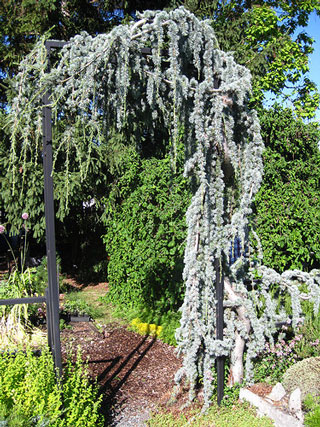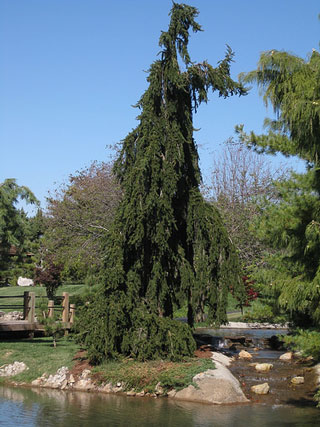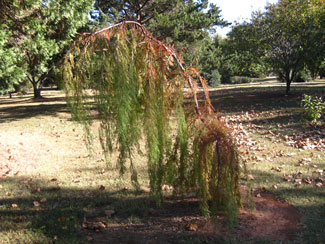Resource Library
Plant of the Week: Conifers, Weeping
Weeping conifers
Cascade Falls bald cypress needs training at an early age to encourage it to develop an upright main trunk. Image courtesy Gerald Klingaman)
Download High Resolution
Especially interesting weeping forms are found in blue Atlas cedar (Cedrus atlantica ‘Glauca Pendula’), white pine (Pinus strobus ‘Pendula’), Norway spruce (Picea abies ‘Pendula’) and bald cypress (Taxodium distichum ‘Cascade Falls’). Each of these weepers has foliage characteristics like the parent species but the growth form of the overall plant is strikingly different. While the non-weeping forms all look more or less alike, each weeping plant of a particular clone is completely unique.
Weeping plants occur occasionally in nature as seedlings. For conifers from snowy regions the pendant form has an advantage in that it helps the tree shed snow. The weeping forms that have been selected as ornamental plants simply exaggerate this already present characteristic.
Some, like the weeping Norway spruce and the weeping white pine, develop a more or less normal trunk and grow unaided as trees with weeping branches. Others, such as weeping blue Atlas cedar and Cascade Falls bald cypress, want to grow horizontally (as if they were from a lateral branch) and will only make an upright main trunk when staked at a young age.
Eventually these staked forms get established and begin growing upright on their own.

No two Weeping Blue Atlas Cedars ever look alike. (Image courtesy Gerald Klingaman)
Download High Resolution
In weeping Norway spruce, the terminal growing point displays a normal geotropic response and knows which way is up. In Cascade Falls bald cypress, the growing point behaves as if it is a side branch and has the geotropic response turned off. Only by righting the stem via staking and waiting a year or two will the growing tip turn on genes that control geotropism and the tip begin to grow upright.
I have a theory of why weepers weep. Lignification – the process of depositing lignin within the cellulose matrix of the cell wall – occurs after the cell has expanded to full size. Lignin, which makes up 25 to 35 percent of the dry weight of a tree, combines with hemicelluloses and gives the tree its rigidity. Lignification occurs quickly as seen when an okra pod is edible one day but the next takes on the characteristics of a well-chewed toothpick. I suspect that lignification is delayed in weeping plants to the point that, as the branch extends outwards and gravity does its thing, the unreinforced cells sag downward. When lignin does finally form the die has been cast and the tree has pendant branches.
Weeping plants are such unique forms they cry out to be used as specimen plants. Choosing the correct location for a specimen is critical and requires careful consideration. Locate it in the wrong place and an eyesore is created, but in the right spot these weepers can look like a piece of well-placed garden sculpture. Generally you want to locate them where they can be seen from a distance and that they have a neutral background that is not cluttered by different, contrasting growth forms.

Weeping Norway Spruce grows as a more or less normal tree but with irregular pendant
branches. Image courtesy Gerald Klingaman)
Download High Resolution
Forms that do not have normal geotropic control should be staked from an early age and carefully pruned to help reestablish apical dominance. These staked trees should be inspected in late winter each season and the weeping tip of the selected terminal attached to the stake. Also the ties supporting the tree should be checked to see that they do not girdle the trunk. Once the trunk has developed sufficient rigidity, keep only the younger part of the terminal in bondage and remove the ties from the main trunk.
By: Gerald Klingaman, retired
Retired Extension Horticulturist - Ornamentals
Extension News - January 24, 2014
